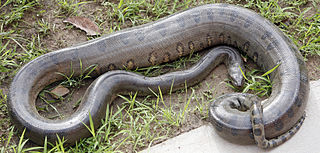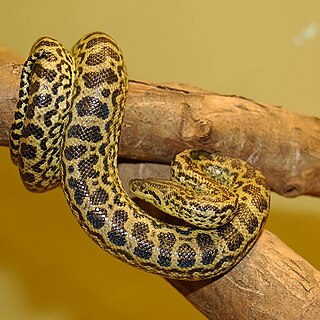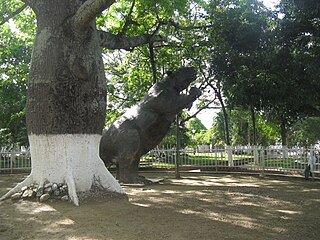
Anacondas or water boas are a group of large snakes of the genus Eunectes. They are found in tropical South America. Four species are currently recognized.

The green anaconda, also known as common anaconda or common water boa, is a non-venomous boa species found in South America. It is the heaviest and one of the longest known extant snake species. The term "anaconda" often refers to this species, though the term could also apply to other members of the genus Eunectes.

The yellow anaconda, also known as the Paraguayan anaconda is a boa species endemic to southern South America. It is one of the largest snakes in the world but smaller than its close relative, the green anaconda. Like all boas and pythons, it is non-venomous and kills its prey by constriction. No subspecies are currently recognized.
La Venta is a fossil locality located in the modern departments of Tolima and Huila in Colombia. This site is one of the richest Neogene fossil assemblages in South America and represents the best-known Cenozoic fossil site outside of Argentina. It provides a glimpse of what life in the region was like before the main wave of the Great American Interchange.
Reports of giant anacondas date back as far as pre-Columbian times, playing a role in indigenous cultures of the Amazon Basin. European colonization of South America reported sightings of giant anacondas. The size of the largest anacondas has been the subject of debate ever since among cryptozoologists and zoologists.
Stirtonia is an extinct genus of New World monkeys from the Middle Miocene. Its remains have been found at the Konzentrat-Lagerstätte of La Venta in the Honda Group of Colombia. Two species have been described, S. victoriae and the type species S. tatacoensis. Synonyms are Homunculus tatacoensis, described by Ruben Arthur Stirton in 1951 and Kondous laventicus by Setoguchi in 1985. The genus is classified in Alouattini as an ancestor to the modern howler monkeys.

Eunectes is a genus of boas found in tropical South America. They are a semiaquatic group of snakes and include one of the largest snakes in the world, E. murinus, the green anaconda. The name Eunectes is derived from the Greek word Eυνήκτης, which means "good swimmer". Four species are currently recognized.

Eunectes deschauenseei is a non-venomous boa species endemic to northeastern South America. No subspecies are currently recognized.

Gryposuchus is an extinct genus of gavialoid crocodilian. It is the type genus of the subfamily Gryposuchinae. Fossils have been found from Argentina, Colombia, Venezuela, Brazil and the Peruvian Amazon. The genus existed from the Middle Miocene to Late Pleistocene. One recently described species, G. croizati, grew to an estimated length of 10 metres (33 ft).
Colombophis is an extinct genus of snakes of the clade Alethinophidia, a group of "primitive" snakes. The genus was first recognized in the Villavieja Formation in the town of Los Mangos, part of the known fossil fauna of La Venta in the department of Huila (Colombia), in the middle Miocene. With the remains of a fossil snake was erected the species Colombophis portai in 1977, based on forty fragmentary vertebrae. These vertebrae are characterized by a low neural spine, and subdivided paradiapophysis and thin zygosphen. The vertebrae are medium to large, so the snake would measure about 1.77 metres long, similar in size to the current Boa constrictor.

Dukecynus is an extinct genus of meat-eating metatherian, belonging to the order Sparassodonta which lived in South America during the Middle Miocene (Laventan), between about 13.8 and 11.8 million years ago. The name of the genus meaning "Duke dog", for the Duke University and the Greek word cynos, dog, for the pretended similarity of this animal with dogs. A single species known so far, Dukecynus magnus. The species name "magnus" derives from Latin for big, to reflect their great size.

Eunectes beniensis is a non-venomous boa species known only from the northeastern parts of Bolivia, but it possibly occurs in adjacent parts of Brazil.

The Honda Group is a geological group of the Upper and Middle Magdalena Basins and the adjacent Central and Eastern Ranges of the Colombian Andes. The group, in older literature also defined as formation, is in its present-day type section in the Tatacoa Desert in the department of Huila subdivided into two main formations; La Victoria and Villavieja.
Micodon is an extinct genus of New World monkeys from the Middle Miocene. Its remains have been found at the Konzentrat-Lagerstätte of La Venta in the Honda Group of Colombia. The type species is M. kiotensis, a very small monkey among the New World species.
Miocallicebus is an extinct genus of New World monkeys from the Middle Miocene. Its remains have been found at the Konzentrat-Lagerstätte of La Venta in the Honda Group of Colombia. The type species is M. villaviejai.
Patasola is an extinct genus of New World monkeys from the Middle Miocene. Its remains have been found at the Konzentrat-Lagerstätte of La Venta in the Honda Group of Colombia. The type species is Patasola magdalenae.
Saimiri fieldsi is an extinct species of New World monkeys in the genus Saimiri from the Middle Miocene. Its remains have been found at the Konzentrat-Lagerstätte of La Venta in the Honda Group of Colombia.
Dracaena colombiana is an extinct species of caiman lizards from northern South America. Fossils of Dracaena colombiana have been found in the Honda Group of Colombia. The species was described as a member of the tegus; Tupinambis huilensis by Estes in 1961.












